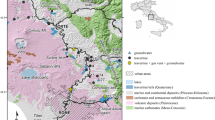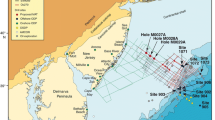Abstract
Formation of travertines from continental waters requires very special conditions. Their porous, cellular and concretionary appearance is often due to calcite incrustations on plants. Therefore the high porosity beside a very low concentration of detrital silicates must be related to a high rate of calcite accumulation (0.1 to 1 mm/year). A high rate of sedimentation from high Ca-concentrations (>0.01%) does not occur in normal continental waters equilibrated with the atmospheric carbon dioxide.
Formation of travertines is probably not an indicator of special climatic conditions as often assumed but is related to a special chemical composition of fresh waters. Creeks with continuous travertine deposition, investigated by us, contain about 200 ppm Ca. This is more than ten times the normal concentration of average continental waters. Bicarbonate concentration in these waters is five times that of equilibrium with atmospheric carbondioxide. Many of the productive waters are characterized by high sulfate concentrations and Sr/Ca-ratios (1000 Sr/Ca ranges from 9 to 22; seawater: 20).
Except one from the Schwäbische Alb 15 samples (Leine-valley, Teutoburger Wald, Thüringen) are high in sulfate and Sr/Ca-ratio to be accumulated in waters with remarkable concentrations in the respective elements. The Sr/Ca-ratios cannot be explained from dissolved limestones underlying the exposed areas. The assumption of dissolution of gypsum beds very well explains our observations and data. From the S32/S34 ratio an origin from Zechstein (Upper Permian), Muschelkalk (Middle Triassic) or Keuper (Upper Triassic) deposits respectively can be assumed. Like other freshwater limestones the travertines under investigation differ from marine carbonates by their light carbon (mean δC13 −8,1) from decomposed organic matter and their light oxygen (mean δO18 −6,7) from exchange with freshwaters. The discrimination freshwater- and marine limestones in oxygen isotopes is only valid for those of low age (Upper Mesozoic to Recent).
Hence the special conditions of travertine formation are related to bicarbonate spring waters which have circulated on faults where they could dissolve gypsum (and/or calcite) from subsurface beds.
Additional examples of travertine deposits from Czechoslovakia (Zyka, 1958), Lüneburger Heide (NW Germany), Italy (Tivoli near Rom) and Jugoslavia can be explained as formations of either sulfate-bicarbonate or of bicarbonate waters.
Similar content being viewed by others
Literatur
Braitsch, O.: Entstehung und Stoffbestand der Salzlagerstätten. Berlin-Göttingen-Heidel-berg: Springer 1962.
Chow, T. J., and T. G. Thompson: Flame photometric determination of strontium in sea water. Anal. Chem. 27, 18–21 (1955).
Clarke, F. W.: The data of geochemistry. U. S. Geol. Surv. Bull. 770, 554–580 (1924).
Cortesi, C., e M. Leoni: Studio sedimentologico e geochimico del travertino di un sondaggio a Bagni di Tivoli. Periodico Mineral. (Rome) 27, 407–460 (1958).
Craig, H.: Isotopic standards for carbon and oxygen and correction factors for mass spectrometric analysis of carbon dioxide. Geochim. Cosmochim. Acta 12, 133–149 (1957).
Dienemann, W., u. K. Fricke: Mineral- und Heilwässer, Peloide und Heilbäder in Niedersachsen und seinen Nachbargebieten. Veröff. Nieders. Inst. f. Landeskunde a. d. Univ. Göttingen, Reihe A, I, 5 (5) (1961).
Flügel, H. W., u. K. H. Wedepohl: Die Verteilung des Strontiums in oberjurassischen Karbonatgesteinen der Nördlichen Kalkalpen. Contr. Mineral. and Petrol. 14, 229–249 (1967).
Fricke, K.: Eine chemisch-geologische Karte der Mineralquellen Nordrhein-Westfalens. Bemerkungen zur Karte und zur Nomenklatur und Begriffsbestimmung der Mineralwässer. Geol. Jahrb. 69 (1953).
Grünnger, W.: Rezente Kalktuffbildung im Bereich der Uracher Wasserfälle. Abhandl. Karst und Höhlenkunde, vol. E-2, p. 1–113. München 1965.
Herrmann, A. G.: Zur Geochemie des Strontiums in den salinaren Zechsteinablagerungen der Staßfurt-Serie des Südharzbezirkes. Chem. Erde 21, 137–194 (1961).
Hiltermann, H., u. G. Lüttig: Der Quellkalk von Laer (Kreis Osnabrück-Land). Naturw. Verein Osnabrück 29, 67–75 (1960).
Keith, M. L., and J. N. Weber: Isotopic and environmental classification of selected limestones and fossils. Geochim. Cosmochim. Acta 28, 1787 (1964).
Knoblauch, G.: Sedimentpetrographische und geochemische Untersuchungen an Weißjurakalken der geschichteten Fazies im Gebiet von Urach und Neuffen. Diss. Tübingen 1963.
Livingstone, D. A.: Chemical composition of rivers and lakes. U.S. Geol. Surv., Profess. Papers 444-G, 1–64 (1963).
Lloyd, R. M.: Oxygen-18 composition of oceanic sulfate. Science 156, 1228–1231 (1967).
Müller, G.: Zur Geochemie des Strontiums in Ozeanen Evaporiten unter besonderer Berücksichtigung der sedimentären Coelestinlagerstätte von Hemmelte-West (Süd-Oldenburg). Geologie 11, Beih. 35, 1 (1962).
Nielsen, H.: Schwefelisotope im marinen Kreislauf und das δS34 der früheren Meere. Geol. Rundschau 55, 160–172 (1965).
—, u. W. Ricke: Schwefel-Isotopen verhältnisse von Evaporiten aus Deutschland; ein Beitrag zur Kenntnis von 34S im Meerwasser-Sulfat. Geochim. Cosmochim. Acta 28, 577–591 (1964).
Odum, H. T.: Strontium in natural waters. Publ. Inst. Marine Sci. (Tex.) 4, 22–37 (1957).
Oxburgh, U. M., R. E. Segnit, and H. D. Holland: Coprecipitation of strontium with calcium carbonate from aqueous solutions. Bull. Geol. Soc. Am. 70, 1653–1654 (1959).
Pia, J.: Die rezenten Kalksteine. Mineral. Petrog. Mitt., Erg.-Bd. (1933).
Ricke, W.: Präparation von Schwefeldioxid zur massenspektrometrischen Bestimmung des Schwefelisotopenverhältnisses S32/S34 in natürlichen Schwefelverbindungen. Z. Anal. Chem. 199, 401–413 (1964).
Schmidt, H.: Göttinger Bausteine geologisch betrachtet. Göttinger Jahrb. 10, 11–18 (1962).
Selle, W.: Interglaziale Süßwassermergel- und Kieselgur-Vorkommen in Niedersachsen. N. Arch. f. Landes- und Volkskunde v. Niedersachsen 3, 234 (1947).
Smykatz-Kloss, W.: Sedimentpetrographische und geochemische Untersuchungen an Karbonatgesteinen des Zechsteins II. Contr. Mineral. and Petrol. 13, 232–268 (1966).
Thode, G. H., J. Monster, and H. B. Dunford: Sulfur isotope geochemistry. Geochim. Cosmochim. Acta 25, 159–174 (1961).
Turekian, K. K.: The marine geochemistry of strontium. Geochim. Cosmochim. Acta 28, 1479–1496 (1964).
—, and K. H. Wedepohl: Distribution of the elements in some major units of the earth's crust. Bull. Geol. Soc. Am. 72, 175–191 (1961).
Wedepohl, K. H.: Untersuchungen am Kupferschiefer in Nordwestdeutschland; Ein Beitrag zur Deutung der Genese bituminöser Sedimente. Geochim. Cosmochim. Acta 28, 305 (1964).
Wunderlich, H. G.: Das Quartär der Grone-Niederung westlich Göttingen. Eiszeitalter — Gegenwart 14, 53 (1963).
Zyka, V.: Die Rolle der Ölfeldwässer bei der Akkumulation und Verteilung der chemischen Elemente. Acta Geol. Acad. Sci. Hung. 5, 435–478 (1958).
Author information
Authors and Affiliations
Additional information
Wir danken der Deutschen Forschungsgemeinschaft für Beihilfen zu dieser Arbeit.
Rights and permissions
About this article
Cite this article
Savelli, C., Wedepohl, K.H. Geochemische Untersuchungen an Sinterkalken (Travertinen). Contr. Mineral. and Petrol. 21, 238–256 (1969). https://doi.org/10.1007/BF00371753
Received:
Issue Date:
DOI: https://doi.org/10.1007/BF00371753




